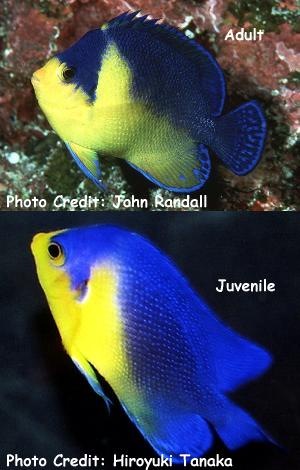
By Bob Goemans

Likely Reef Tank Suitable
Likely Fish-Only Tank Suitable
Range: Western Pacific Ocean: Southern Japan, Taiwan and Ryukyu Islands, and to the Philippines.
Size: 5 inches (12 cm)
Natural Environment: Inhabits steep outer coral and rocky reef slopes from 20 to over 130 feet (6 – 40 m) in depth, and normally lives in caves. Its diet consists mainly of sponges, tunicates and various crustaceans.
General Husbandry: This beautiful and somewhat rare dwarf angelfish has yellow body and face area, with a triangular blue patch on top of the head, and a blue colored saddle area that starts near the front dorsal fin and extends overs the rear portion of the body and caudal fin. Anal and pelvic fins are edged in blue.
Not normally seen in the U.S. aquarium trade and rarely available, yet when so, an exceptional addition to most aquariums! Even though not much is known about its exact diet and aquarium care, it should no doubt mimic that of other deep water species because of its normally being found in caves. Therefore, it would be best to maintain this species in only well established aquariums containing lots of live rock that will provide it many caves and crevices to explore and/or hide in when feeling threatened. And that frozen foods including fortified brine shrimp, mysis, and especially those containing sponge matter/angelfish food preparations be offered several times a day. Yet, more definitive information is needed before one can precisely denote its care/needs.
Its also best there be only one species from this dwarf angelfish genus in the aquarium, as they tend to develop aggression toward other dwarf angelfish and it be the last fish to be added as it can be quite feisty with newcomers.
Nevertheless, it can be quite shy when first entering the aquarium, and will hide in caves and crevices. But as time passes, will become more outgoing and begin to establish its territory. Not suited for small nano style aquariums, as they will not only become very aggressive in small aquariums, they will, without numerous feedings per day, be able to find enough food to be maintained long-term.
Taxonomy:
Order: Perciformes
Suborder: Percoidei
Family: Pomacanthidae
Genus: Paracentropyge, Centropyge, Holacanthus, Sumireyakko
FYI: All Centropyge species start life as unsexed individuals, but begin their adult life as females. Then, the larger or more dominant individual within small groups will change sex within a few days to a couple of weeks and become a male. Knowing that size is the main difference between the sexes, and not so much its coloration, all one needs to do is place a small and larger specimen together. Within approximately sixty days one of the two fish will have physically changed sex to accommodate the other. A reversal of this sex change is possible if the need arises, but that requires much more time, e.g., weeks to months.
Keep in mind all angels have cheekspines at the edge of their gill cover; therefore use caution when handling and also avoid using a net to capture it, as it may become stuck or tangled in the net and become damaged when removed.
Synonyms - Paracentropyge venusta, Centropyge venusta, Centropyge venustus, Holacanthus venustus, Sumireyakko venustus
Experience Level: Intermediate
Temperament: Semi-aggressive
Diet: Omnivore
Acclimation Time: 30 minutes+
Aquarium Environment: Reef or fish-only aquarium
Reef Safe: With caution caution – may have a tendency to nip clam mantles, yet does fairly well with large and small polyped stony (LPS and SPS) corals.
Minimum Tank Size: 50 gallons
Temperature Range: 72 - 81°F (22 – 27°C).
Specific Gravity: 1.020-1.027
pH: 8.0 - 8.5
